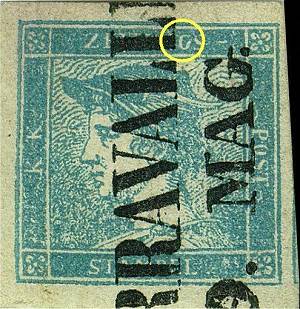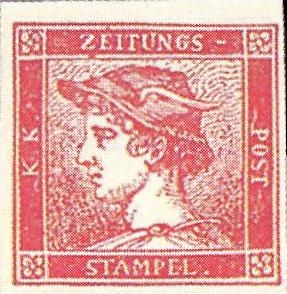MERCURY
It was so called by the subject,
the winged head of the Mercury God, in profile facing left. The drawing, of
square shape, was made by Josef Axmann: and it is constituted by two concentrically
placed squares, the first one containing the Mercury head, the second one
delimits a frame with the label "K.K. ZEITUNGS POST STAMPEL"
(read in clockwise direction from left to right); in the corners there are
4 small ornaments. It was printed obviously in Vienna in the Royal Printing
House in sheets of 400 pieces divided in 4 groups of 100 each (10 rows of
10 pieces) separated by an inter-space, on machine made paper without watermark,
of variable thickness. Printing is somehow "raw" and is obtained
starting from an engraving in wood, quite different from the general quality
of the Lombardy-Venetia stamps. They were valid up to May 31st 1864.
The Mercury was printed in typography with different colors depending on the
number of newspaper copies that were supposed to be shipped. The BLUE stamp
was used applied to one copy of the newspaper and was equivalent to 1.05 Soldi
(3 centesimi); the YELLOW one was supposed to be applied to the wrapper of
10 copies of newspapers (and was equivalent to 10.5 Soldi or 30 centesimi)
while the PINK one was supposed to be applied to the wrapper of 50 copies
of newspapers (was equivalent to 52.5 Soldi or 1.50 Lire).
The Pink revenue very soon was not anymore printed (in 1852) and the remainders
were used applied to single newspaper copies. Then it was the time of the
Yellow Mercury (1856) because too pale, it was substituted by a RED Mercury
that anyway does not result to be ever used in Lombardy-Venetia (no known samples).
Of the Blue Mercury a sub-type exists printed on machine made paper, ribbed
vertically in dry after printing.
It is unknown the number of revenues printed. Do exist varieties as offsets,
group's inter-spaces and marks of typographic spaces. Several official reprints
were made in the 1866, 1870, 1884, 1886, 1887, 1894, 1904.
Three different sub-types of the Blue Mercury exist due to the fact that the
first printing matrix got worn and was progressively substituted with other
two. Here is how to identify the three types:
1st TYPE: the letter "G" of the word "ZEITUNGS" in the upper label is without the horizontal trait and it looks like a "C". The parts on ribbed paper are of this type (Fig. 1).

Fig. 1:
first type
2nd TYPE: the letter "G" of the word "ZEITUNGS" in the upper label is completed. In addition between the word "POST" and the right margin we can see sometimes several color dots (Fig. 2).

Fig. 2:
second type
3rd TYPE: the letter "G" of the word "ZEITUNGS" in the upper label is correct but it does present one or two color dots in the curved part, at bottom (Fig. 3).

Fig. 3: third type
